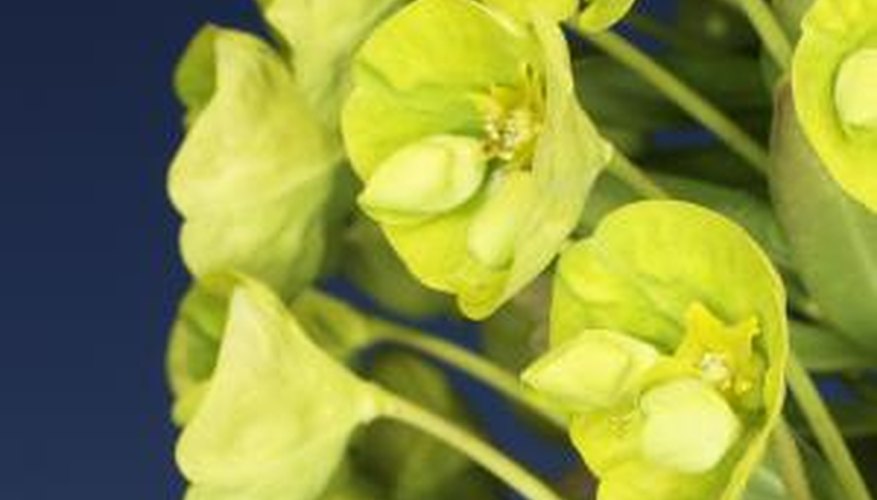Euphorbia esula, commonly known as leafy spurge, can dominate fallow fields and areas such as railroad cuts, roadsides and gullies. A native of Eastern Europe and western Asia, this tall, weedy plant has spread to many parts of the U.S., and its lack of natural enemies in North America has contributed to its vigour. You can remove this hardy invasive plant, but it will take persistence and a combination of methods.
Pull by hand any young spurge plants during their blooming stage, typically from late May to mid-June. Wear gloves to protect your hands from the plant's milky sap, which can irritate skin.
Mow larger plants before they set seeds, usually in mid-July.
In early September, apply herbicide, such as glyphosate, covering the leaves and broken stems. At this time of year, the spurge is moving nutrients from the leaves into the roots for winter storage, and the herbicide will be absorbed as well, and will be more effective.
- Euphorbia esula, commonly known as leafy spurge, can dominate fallow fields and areas such as railroad cuts, roadsides and gullies.
- At this time of year, the spurge is moving nutrients from the leaves into the roots for winter storage, and the herbicide will be absorbed as well, and will be more effective.
Remove new shoots the following spring as they appear, usually by early May, using a power cultivator or a duck-foot tiller. You can also use a springtooth harrow, but you will have to use it more frequently.
Repeat the tilling every two to three weeks during the growing season; if you use a springtooth harrow, use it every week.
Apply herbicide again in early September, covering the leaves and broken stems.
Watch the spurge patch carefully the following year, and continue the removal for a second year if the infestation remains severe. Left untreated, spurge can rapidly re-establish itself.
TIP
If your infestation is particularly large, or if you fail to eradicate it, consult your local agricultural extension agent for advice about approaches such as controlled burns or biological countermeasures. The extension agents will know what strategies have worked best in your local area. Once you have eradicated or limited the spurge, plant the area as soon as possible with a sustainable competitor plant that will keep the spurge from re-establishing itself. The National Park Service's Integrated Pest Management Manual recommends sorghum or soybeans. Some competitor plants, such as couch grass or clovers, can themselves become invasive; consult your local agricultural extension to find out what cover crops might work best for your location and soil type.
WARNING
The milky, sticky sap of leafy spurge can not only irritate human skin, but animals as well. Most animals will not graze on spurge, though sheep can do so safely. Do not pasture other animals in heavily infested fields or cut spurge for hay. Because leafy spurge can grow back from a small portion of root, it is important to keep up eradication methods and vigilant observation season after season. Keep an eye on the entire area, along with any freshly cleared land or "waste" ground. Seeds can disperse as much as 15 feet from the parent plant, and roots can reach twice as far, helping the plant to spread easily.
